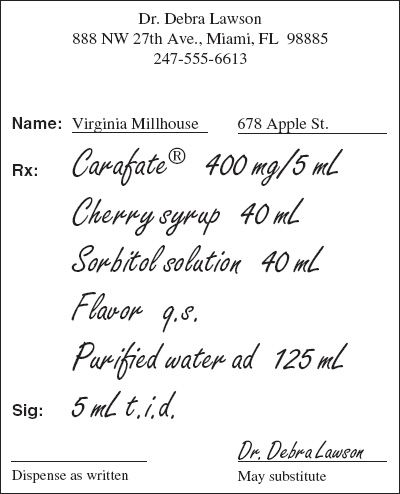TERMS
•Compounding pharmacy
•Extemporaneous compounding
•Prefabricated dosage form
•Scored tablet
OBJECTIVES
Upon completion of this chapter, the technician student will be able to:
•Calculate the amounts of a specific drug product from a prefabricated dosage form required to extemporaneously compound specific products.
•Calculate the percentage strength of a drug in a formula.
•Calculate the concentration of a specific drug in a formula.
The extemporaneous compounding of prescriptions and medication orders is an activity for which pharmacists and technicians are uniquely qualified by virtue of their education, training, and experience. Many pharmacists also develop and compound specialized pharmaceutical formulas. Specialized compounding pharmacies have created a new and growing practice site for pharmacy technicians. Pharmacy technicians in this specialized practice perform the necessary calculations and then compound the product (Fig. 14.1). This chapter presents some calculations that apply to these areas of practice.
extemporaneous compounding Mixing, assembling, packaging, and labeling of medication for a specific patient upon receipt of a prescription order.
compounding pharmacy A pharmacy that compounds prescriptions to order.
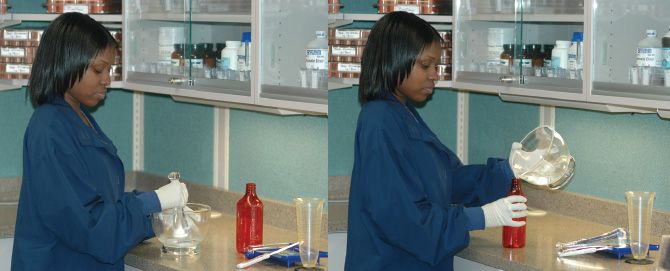
Figure 14.1A pharmacy technician demonstrating trituration (grinding of powders in a mortar with a pestle) in a glass mortar and then transferring the completed product into an amber oval for dispensing.
 Use of Prefabricated Dosage Forms in Compounding
Use of Prefabricated Dosage Forms in Compounding
Pharmacists frequently find that bulk supplies of certain proprietary drug substances are not available for extemporaneous compounding and that prefabricated tablets, capsules, injections, and other dosage forms are the only source of the agent. This situation occurs, for example, when a patient is unable to swallow capsules and tablets, and the commercially available tablets or capsules must be used to prepare a liquid form of the same medication.
When using commercially prepared dosage forms as the source of a medicinal agent, the pharmacist selects products in the simplest, most economical and convenient form. For both convenience and economy, use of the fewest dosage units is preferred, for example, 5 100-mg tablets rather than 100 5-mg tablets. An injection often provides a convenient source of medicinal agent when the volume required is small and the injection is compatible with the physical characteristics of the dosage form being prepared (e.g., an oral liquid rather than dry-filled capsules). The technician may have to research the product to make sure that in its altered form (solid to liquid) or route (injection to oral) it will maintain its bioavailability, that the extemporaneous vehicle is compatible with the product, and that the drug will not precipitate.
Occasionally small whole or broken tablets (scored tablets) (Fig. 14.2) of the prescribed strength may be placed within capsule shells. Usually, however, tablets are crushed to powder in a mortar. When capsules are used as the drug source, the capsule shells are opened and their powdered contents expelled. The correct quantity of powder is then used to fill the prescription or medication order, as shown in Figure 14.3.
scored tablet A tablet with a groove pressed into it to make the tablet easy to break.
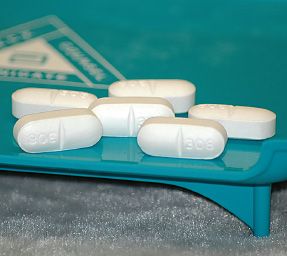
Figure 14.2 Scored tablets.
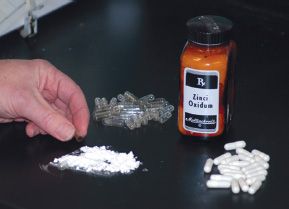
Figure 14.3A pharmacy technician filling zinc oxide capsules by hand.
In addition to the medicinal agent, most solid dosage forms contain materials such as fillers, binders, and disintegrants. These ingredients may have to be considered in the required calculations. For example, a tablet labeled to contain 10 mg of a drug may actually weigh 200 mg or more because of the added ingredients. Calculations involved in the use of injections generally are relatively simple because injections are labeled according to quantity of drug per unit volume, such as milligrams per milliliter.
In addition to the use of tablets in compounding procedures, certain tablets are designed to be used as a premeasured source of a drug substance in the preparation of a solution, such as halazone tablets for solution, USP.
Examples of problems requiring the use of prefabricated dosage forms follow.
prefabricated dosage form The dosage form available from the manufacturer (e.g., tablets and capsules).
Rules for Using Prefabricated Dosage Forms
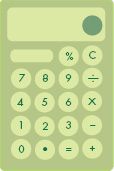
Step 1. Calculate the amount of drug required for the formula.
Step 2.Calculate the amount of the prefabricated dosage form to be used.
Examples:
Indomethacin is available only in 25-mg capsules. How many capsules must be used to obtain the amount of indomethacin needed in preparing the following prescription?
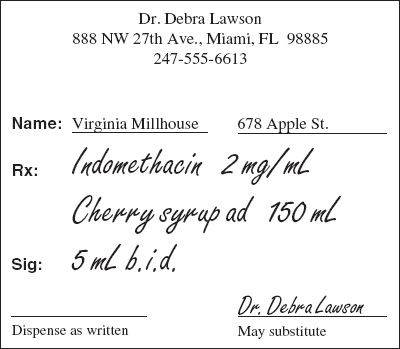
Because 2 mg/mL of indomethacin is prescribed, 300 mg is needed to prepare the prescription.
Each capsule contains 25 mg of indomethacin.
![]()
Or use ratio-proportion:

The drug Lopressor® is available as 50-mg tablets. Before preparing the following prescription, a pharmacist determined that each tablet weighed 120 mg. Explain how to obtain the proper quantity of Lopressor®.
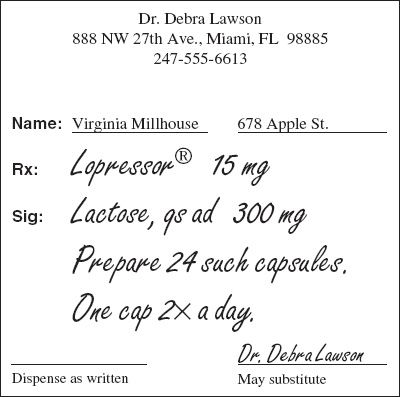
15 (mg) × 24 = 360 mg of Lopressor® needed.
Crush 8 tablets:

Therefore, 8 tablets will be crushed and 864 mg will be weighed; this amount will supply the 360 mg required.
How much (in milliliters) of an injection containing 40 mg of triamcinolone per milliliter may be used in preparing the following prescription?
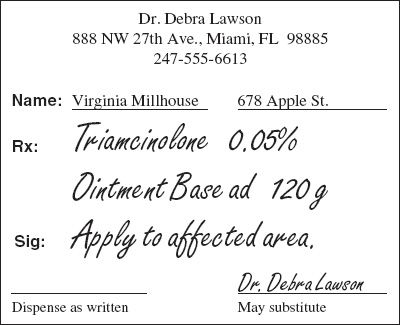

Drawing up 1.5 mL of triamcinolone 40 mg/mL will provide the 60 mg needed.
The only source of sodium chloride is in the form of 1-g tablets. How should the technician obtain the amount of sodium chloride needed for the following prescription?

50 (g) × 0.009 = 0.450 g of sodium chloride needed.
Because one tablet contains 1 g of sodium chloride or 20/9 times the amount desired, 9/20 of the tablet will contain the required quantity, or 0.450 g. The required amount of sodium chloride may be obtained as follows:
Dissolve one tablet in enough purified water to make 20 mL of dilution.
Take 9 mL of the dilution, answer
The only source of potassium permanganate is in the form of 0.3-g tablets for topical solution. How should the technician obtain the amount of potassium permanganate needed for the following prescription?

1:5000 = 0.02%
250 (g) × 0.0002 = 0.050 g or 50 mg of potassium permanganate needed.
Because one tablet for topical solution contains 300 mg of potassium permanganate, or six times the amount needed, ![]() of the tablet will contain the required amount or 50 mg. The required quantity of potassium permanganate may be obtained as follows:
of the tablet will contain the required amount or 50 mg. The required quantity of potassium permanganate may be obtained as follows:
Dissolve one tablet for topical solution in enough purified water to make 60 mL of dilution.
Take 10 mL of the dilution, answer
Review Set 14.1: Use of Prefabricated Dosage Forms in Compounding
1.How should the technician obtain the amount of potassium permanganate needed for the following prescription from 0.3-g potassium permanganate tablets?
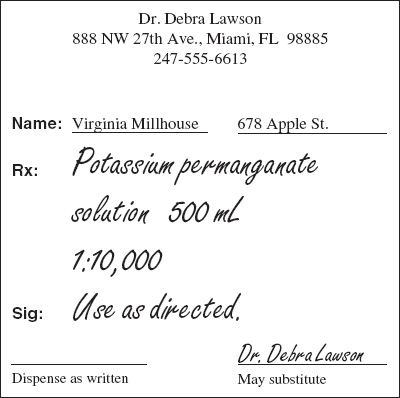
2.How many tablets, each containing 600 μg of scopolamine hydrobromide, should be used to prepare the following prescription?
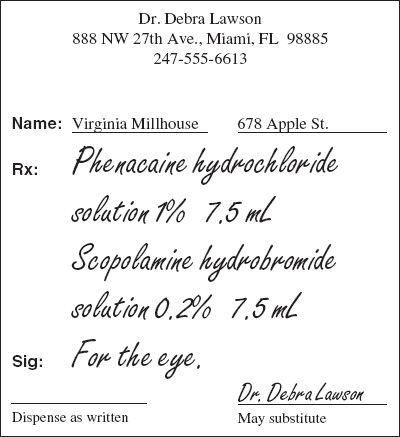
3.How much (in milliliters) of a 0.9% solution of sodium chloride can be made from 10 tablets for solution, each containing 2.25 g of sodium chloride?
4.How much (in milliliters) of an injection containing 40 mg of a drug per milliliter would provide the amount of the drug needed to prepare 120 mL of a 0.2% suspension?
5.How many tablets for a topical solution, each containing 300 mg of potassium permanganate, should be added to 1 gal of purified water to provide a concentration of 0.012% (w/v)?
6.The only source of dantrolene sodium for the prescription below is 100-mg capsules, each containing 200 mg of drug diluent powder mix.
a.How many capsules must be opened?
b.How much (in milligrams) of the powder mix should be used in preparing the prescription?
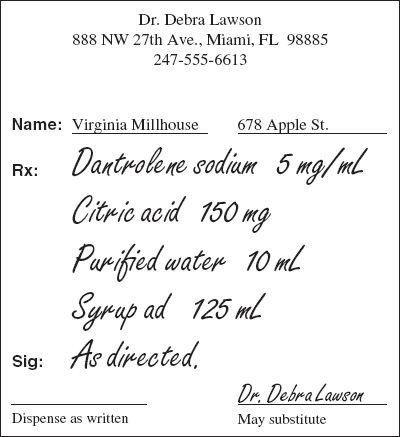
7.How many 10-mg Tordol® (ketorolac tromethamine) tablets must be used to prepare the following prescription?1
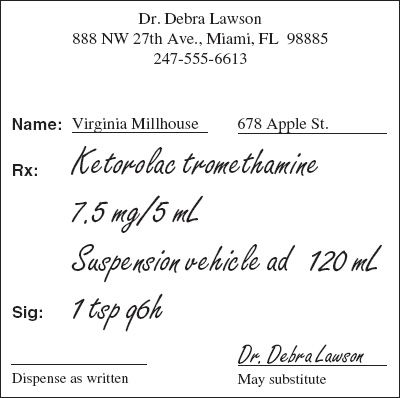
8.How many Dantrium® capsules, each containing 25 mg of dantrolene, are needed to prepare 100 mL of a pediatric suspension containing 5 mg/mL of dantrolene?
9.How many 75-mg capsules of indomethacin should be used in preparing the following prescription?

10.A starting pediatric dose of Dilantin® sodium (phenytoin sodium) is 6 mg/kg per day, administered in three equal divided doses. Using tablets containing 50 mg of phenytoin sodium, a pharmacist prepared a suspension such that each 1 mL, delivered from a calibrated dropper, contained a single dose for a 44-lb child. How many tablets should be used to prepare 30 mL of the suspension?
11.How many 1-g tablets of Carafate should be used to prepare the following prescription?
